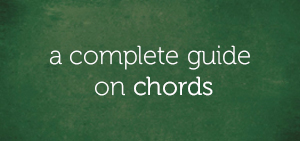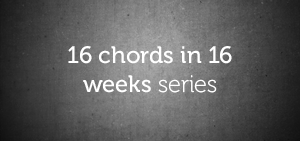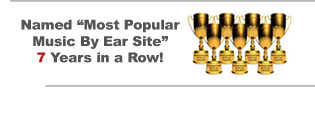In this lesson, we’ll be exposing the power of the dominant seventh [flat ninth] chord and how you can take advantage of it.
Although there are so many dominant chord varieties, the dominant seventh [flat ninth] chord has its unique place in jazz and gospel harmony and I’ll be telling you why this is so in this lesson.
Right before we go into all that, let’s breakdown the dominant seventh [flat ninth] chord.
A Quick Breakdown Of The Dominant Seventh [Flat Ninth] Chord
According to Jermaine Griggs, “a chord is a collection of three or more related notes (agreeable or not) that may be played or heard together.”
Due to the fact that the dominant seventh [flat ninth] chord is basically a dominant seventh chord, let’s start this breakdown by observing the dominant seventh chord closely.
A Short Note On The Dominant Seventh Chord
The term dominant is used to describe the fifth tone of the scale. Therefore, all dominant chords are basically chords of the fifth tone of the scale.
The dominant seventh chord is a chord of the fifth tone of the scale, encompassing seven scale tones.
For example, in the key of C major:
…the dominant seventh chord can be formed on the fifth tone of the scale (which is G):
Starting from G:
…it extends to B:
…D:
…and F:
…encompassing a seventh interval (G to F):
…to form the G dominant seventh chord:
Suggested reading: Dominant Seventh Chords
The Dominant Seventh [Flat Ninth] Chord — Explained
There are two aspects of the dominant seventh [flat ninth] chord:
The dominant seventh
The flat ninth
Now that we’ve covered one aspect of the dominant seventh [flat ninth] chord — the dominant seventh — let’s go ahead and consider the flat ninth.
Beyond the dominant seventh chord is the ninth. For example, beyond the G dominant seventh chord:
…is the ninth (which is A):
Lowering the ninth by a half step produces the flat ninth. Which entails lowering the A:
…by a half step (to Ab):
…to produce the G dominant seventh [flat ninth] chord:
The G dominant seventh [flat ninth] chord is one of the several dominant seventh [flat ninth] chords on the keyboard.
“Check Out The Rest Of Them…”
C dominant seventh [flat ninth] chord:
Db dominant seventh [flat ninth] chord:
D dominant seventh [flat ninth] chord:
Eb dominant seventh [flat ninth] chord:
E dominant seventh [flat ninth] chord:
F dominant seventh [flat ninth] chord:
F# dominant seventh [flat ninth] chord:
Ab dominant seventh [flat ninth] chord:
A dominant seventh [flat ninth] chord:
Bb dominant seventh [flat ninth] chord:
B dominant seventh [flat ninth] chord:
The Power Of The Dominant Seventh [Flat Ninth] Chord
There are basically two dominant chord types: dominant chords that resolve to major chords and dominant chords that resolve to minor chords.
For example, the C dominant thirteenth [suspended fourth] chord:
…resolves to the F major ninth chord:
…while the C dominant seventh [sharp nine, sharp five] chord:
…resolves to the F minor ninth chord:
Although in certain situations, advanced players can use dominant chords that are designated to major chords to resolve to minor chords or vice-versa, in standard practice, every dominant chord is designed either to resolve to a major chord or a minor chord.
The Power Of The Dominant Seventh [Flat Ninth] Chord
The dominant seventh [flat ninth] chord is one of the rare dominant chord types that resolve to major and minor chords. For example, the G dominant seventh [flat ninth] chord:
…can resolve to the C major seventh chord:
…and the C minor seventh chord:
…as well.
It’s also worthy to note that the dominant seventh [flat ninth] chord consists of two mutual tritones. In the C dominant seventh [flat ninth] chord:
E to Bb:
…is a tritone (diminished fifth interval), and so is G to Db:
Unlike other dominant chord types with just a tritone, the dominant seventh [flat ninth] chord consists of two tritones that are a minor third apart from each other.
“In A Nutshell…”
The dominant seventh [flat ninth] chord is one of the important dominant chord types due to its degree of activity and tendency to resolve. Additionally,the dominant seventh [flat ninth] chord can resolve to major or minor chords.
Final Words
If you’re already familiar with the sound of the dominant triad and the dominant seventh chord, and you’re interested in learning other interesting and sophisticated dominant chord types, then you need to learn and master the dominant seventh [flat ninth] chord.
See you in the next lesson!
Chuku Onyemachi
Latest posts by Chuku Onyemachi (see all)
- The Formation Of Diminished Seventh Chords Used To Be Challenging Until I Did This
- How To Form Seventh Chords In Two Shakes Of A Dog’s Tail Using Third Intervals And The Circle Of Fifths Chart
- I Played The 13sus4 Chord And This Happened…
- How To Build Seventh Chords Like An Architect Using “Foundation And Structure” Concept
- This 4-Week Plan Will Help You Master All The Major Scales







Comments on this entry are closed.